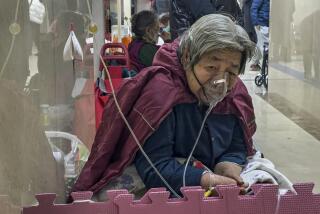China says it’s calmed down
BEIJING — The number of “mass incidents” in China, a reference to protests, riots and other forms of social unrest, fell by one-fifth in the first nine months of 2006, according to Chinese government statistics released Tuesday.
The official New China News Agency, quoting Liu Jinguo, a vice minister of the nation’s Public Security Ministry, reported that police dealt with 17,900 disturbances from January through September, a drop of 22.1%.
At the same time, Liu warned that unapproved religious groups gained in number and clout.
Government statistics in China have long been viewed with skepticism by those who say they tend to be inaccurate and engineered for political purposes. With President Hu Jintao and Premier Wen Jiabao having made social stability a cornerstone of their administration, some analysts wonder whether the statistics are geared toward showing progress on that front.
“The government has never defined what ‘mass incidents’ refer to, so it’s hard to tell if we’re comparing apples and oranges,” said Robin Munro, research director of the China Labor Bulletin, a Hong Kong-based activist group that monitors labor conditions and worker complaints in China.
“I’m instinctively suspicious of official Chinese statistics, which tend not to be reliable, especially when they’re dealing with social instability,” he said.
But others say the numbers demonstrate that the government’s bid to reduce social tension in keeping with its “harmonious society” slogan appears to be showing short-term results. Police are now required to meet with citizens who have grievances, said Hu Xingdou, an economics professor at the Beijing Institute of Technology, and some social security programs have been expanded and more farmers included in income-guarantee programs.
“These all ease conflict to a certain degree and solve some unjust cases,” Hu said.
Though China’s leaders have focused on raising rural incomes, a recent study by the China Labor Bulletin found that wages of female migrant workers in Dongguan, a city in the southern province of Guangdong, in effect remained flat over the last decade even as prices soared and the income of government workers and Communist Party officials grew fivefold.
“From our work, I don’t get a sense society is becoming more harmonious,” Munro said. “Corruption, abuse of power at local levels, land seizures across the country all seem to be getting worse.... There’s a big squeeze on many segments of the population.”
Another question is whether China is seeing fewer mass incidents or whether fewer are being reported. In recent months, the powerful Propaganda Ministry has issued rules banning coverage of public disturbances without authorization.
This dovetails with the Hu administration’s bid to expand its control over civic groups, Internet essayists, public interest lawyers, activists, academics and other potential critics.
That said, China’s rapid economic and social transformation, widening gaps in wealth and employment and massive migration of rural residents to urban areas would challenge almost any government.
Some analysts suggest the nature of Chinese disturbances may be changing, with fewer occurring among rural residents and more among migrant workers and students. But they acknowledge that is difficult to substantiate.
In recent months, several campuses have erupted as a growing number of graduates fight for fewer jobs. Beijing is particularly sensitive about university protests in the wake of the 1989 student-led Tiananmen Square unrest that saw several hundred students killed.
In late October, students at Ganjiang College and Jiangxi Clothing Vocational College, two trade schools in the eastern province of Jiangxi, took to the streets, overturning cars, setting fire to buildings and smashing windows after administrators allegedly misrepresented the type of diplomas that graduates could expect. Calm returned only after riot police were called in.
Even some who believe that recent government efforts to lower rural taxes, reduce fees and eliminate tuition for farmers’ children are reducing social tension question whether the trend can last. “The measures the government has taken only solve the symptoms, not the root,” said Hu, the economics professor. “I don’t see this downward trend lasting more than two or three years.”
Despite the statistics, analysts say, social unrest is likely to increase in the absence of a functioning legal system, greater supervision over government and party officials, protection for whistle-blowers, greater leeway for the media to expose corruption and more rights for workers, farmers and migrants.
*
More to Read
Sign up for Essential California
The most important California stories and recommendations in your inbox every morning.
You may occasionally receive promotional content from the Los Angeles Times.










